Your cart is currently empty!
Tag: Japanese grammar tips
-
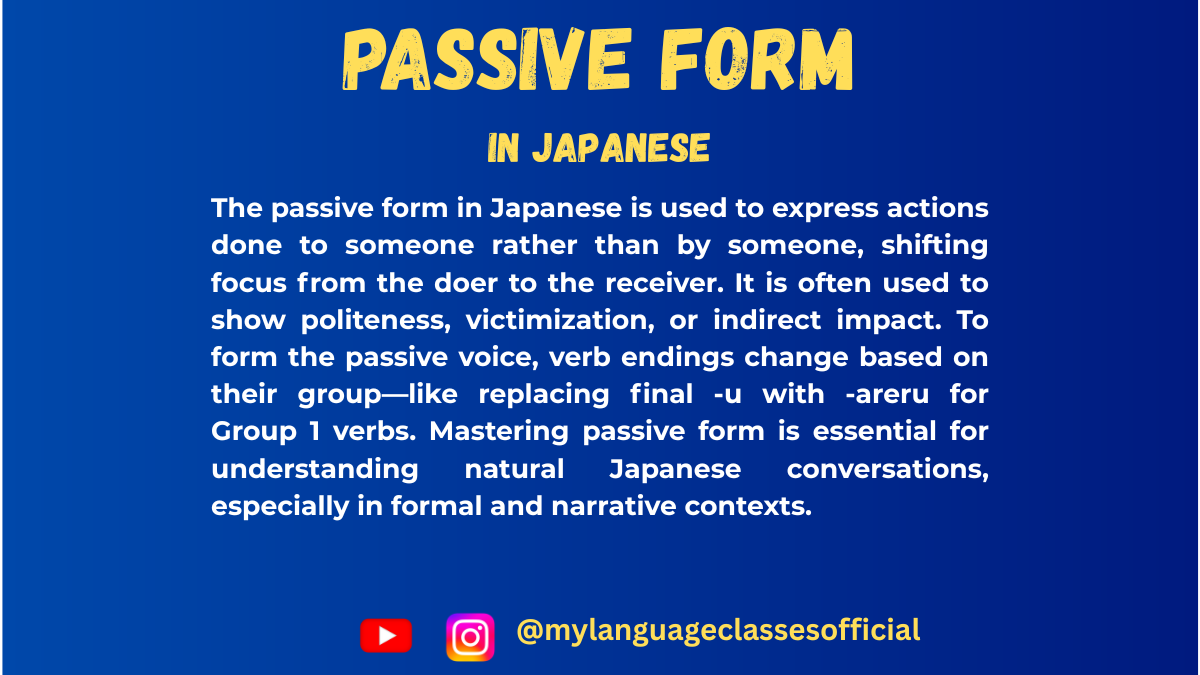
Passive Form of Verbs in Japanese | My Language Classes
Understanding Passive Form in Japanese
The passive form (受身形, うけみけい) in Japanese is used in various situations, primarily to describe actions where the subject is affected by someone else’s actions. Unlike in English, where the passive voice is often avoided, Japanese frequently uses it in daily conversations and formal writing. In this blog post, we will thoroughly explore the formation and usage of passive verbs in different contexts.
Usage of Passive Form in Japanese
The passive form is used in the following situations:
- When someone is negatively affected by an action (被害受身 – ひがいうけみ)
- Japanese: 私は弟にケーキを食べられました。
- Romaji: Watashi wa otōto ni kēki o taberaremashita.
- Meaning: I had my cake eaten by my younger brother.
- When describing an event from the perspective of the affected person
- Japanese: 私は先生にほめられました。
- Romaji: Watashi wa sensei ni homeraremashita.
- Meaning: I was praised by my teacher.
- When discussing historical or public events
- Japanese: このお寺は100年前に建てられました。
- Romaji: Kono otera wa hyaku nen mae ni tateraremashita.
- Meaning: This temple was built 100 years ago.
- When avoiding mentioning the doer explicitly (formal, impersonal expressions)
- Japanese: 日本ではお米が多く食べられています。
- Romaji: Nihon de wa okome ga ōku taberareteimasu.
- Meaning: Rice is widely eaten in Japan.
- When talking about natural phenomena
- Japanese: その山は雪で覆われています。
- Romaji: Sono yama wa yuki de ōwareteimasu.
- Meaning: That mountain is covered with snow.
- In literary or poetic expressions
- Japanese: 彼女の歌は世界中で聞かれています。
- Romaji: Kanojo no uta wa sekaijū de kikareteimasu.
- Meaning: Her songs are heard all over the world.
Formation of Passive Verbs
Japanese verbs are categorized into three groups. The passive form is formed differently for each group.
Group 1 (Ichidan verbs / 一段動詞)
Formation: Drop the final る and add られる
Verb Potential Form Passive Form Example Sentence (Japanese) Romaji Meaning 食べる (たべる) 食べられる 食べられる 私は友達にお菓子を食べられた。 Watashi wa tomodachi ni okashi o taberareta. I had my sweets eaten by a friend. 見る (みる) 見られる 見られる 私の秘密はみんなに見られた。 Watashi no himitsu wa minna ni mirareta. My secret was seen by everyone. 教える (おしえる) 教えられる 教えられる 日本語は先生に教えられた。 Nihongo wa sensei ni oshierareta. Japanese was taught by the teacher. Group 2 (Godan verbs / 五段動詞)
Formation: Change the final u sound to a sound and add れる
Verb Potential Form Passive Form Example Sentence (Japanese) Romaji Meaning 書く (かく) 書ける 書かれる 私の名前が黒板に書かれた。 Watashi no namae ga kokuban ni kakareta. My name was written on the blackboard. 読む (よむ) 読める 読まれる この本は多くの人に読まれた。 Kono hon wa ōku no hito ni yomareta. This book was read by many people. 言う (いう) 言える 言われる 先生に「すごい」と言われた。 Sensei ni “sugoi” to iwareta. I was told “amazing” by the teacher. Group 3 (Irregular verbs / 不規則動詞)
Verb Potential Form Passive Form Example Sentence (Japanese) Romaji Meaning する できる される 彼の仕事は上司に評価された。 Kare no shigoto wa jōshi ni hyōka sareta. His work was evaluated by the boss. 来る (くる) 来られる 来られる 私の家に友達が来られた。 Watashi no ie ni tomodachi ga korareta. A friend came to my house.
More Example Sentences
- 彼は友達にからかわれた。 (Kare wa tomodachi ni karakawareta.) – He was teased by his friends.
- 雨が降って、試合が中止された。 (Ame ga futte, shiai ga chūshi sareta.) – The match was canceled due to rain.
- 私の自転車が盗まれた。 (Watashi no jitensha ga nusumareta.) – My bicycle was stolen.
- その映画は世界中で見られている。 (Sono eiga wa sekaijū de mirareteiru.) – The movie is being watched worldwide.
- 彼は先生に叱られた。 (Kare wa sensei ni shikarareta.) – He was scolded by the teacher.
- この本は多くの人に読まれた。 (Kono hon wa ōku no hito ni yomareta.) – This book was read by many people.
- 先生に質問が聞かれた。 (Sensei ni shitsumon ga kikareta.) – A question was asked by the teacher.
- 日本では魚がよく食べられる。 (Nihon de wa sakana ga yoku taberareru.) – Fish is often eaten in Japan.
- その話は新聞に書かれていた。 (Sono hanashi wa shinbun ni kakareteita.) – That story was written in the newspaper.
- 彼の名前は歴史に残されている。 (Kare no namae wa rekishi ni nokosareteiru.) – His name is left in history.
Fill in the Blanks Exercise:
- 私の名前が黒板に____。
- 先生にほめ____。
- 私は友達にお弁当を____。
- その建物は100年前に____。
- その映画はたくさんの人に____。
- 宿題が____。
- 彼は友達に____。
- その話は新聞に____。
- 日本では魚がよく____。
- 彼の仕事は上司に____。
Answers:
- 書かれた 2. られた 3. 食べられた 4. 建てられた 5. 見られた 6. された 7. からかわれた 8. 書かれた 9. 食べられる 10. 評価された
Things to Keep in Mind
- Passive verbs often imply an indirect effect on the subject.
- Passive form is commonly used in formal writing and polite speech.
- Certain verbs are more frequently used in passive form, such as 言う (to say), 書く (to write), and する (to do).
- When the subject is negatively affected, the nuance of 被害受身 (negative passive) comes into play.
- Passive sentences often omit the doer (agent) for a softer, indirect tone.
Conclusion
Mastering the passive form of verbs in Japanese is crucial for fluency and understanding natural speech patterns. It is widely used in both formal and informal contexts. By practicing passive verb conjugations and understanding their nuanced usage, learners can improve their comprehension and communication skills in Japanese effectively. Keep practicing and using these forms in daily conversation to become more proficient!
If you enjoyed this lesson, be sure to check out more posts like this on my blog at My Language Classes. Don’t forget to subscribe my YouTube channel and follow me on Instagram for the latest language learning tips and lessons. Leave a comment below to share your thoughts, or ask any questions you have about nouns.
Happy learning! 😊
- When someone is negatively affected by an action (被害受身 – ひがいうけみ)
-
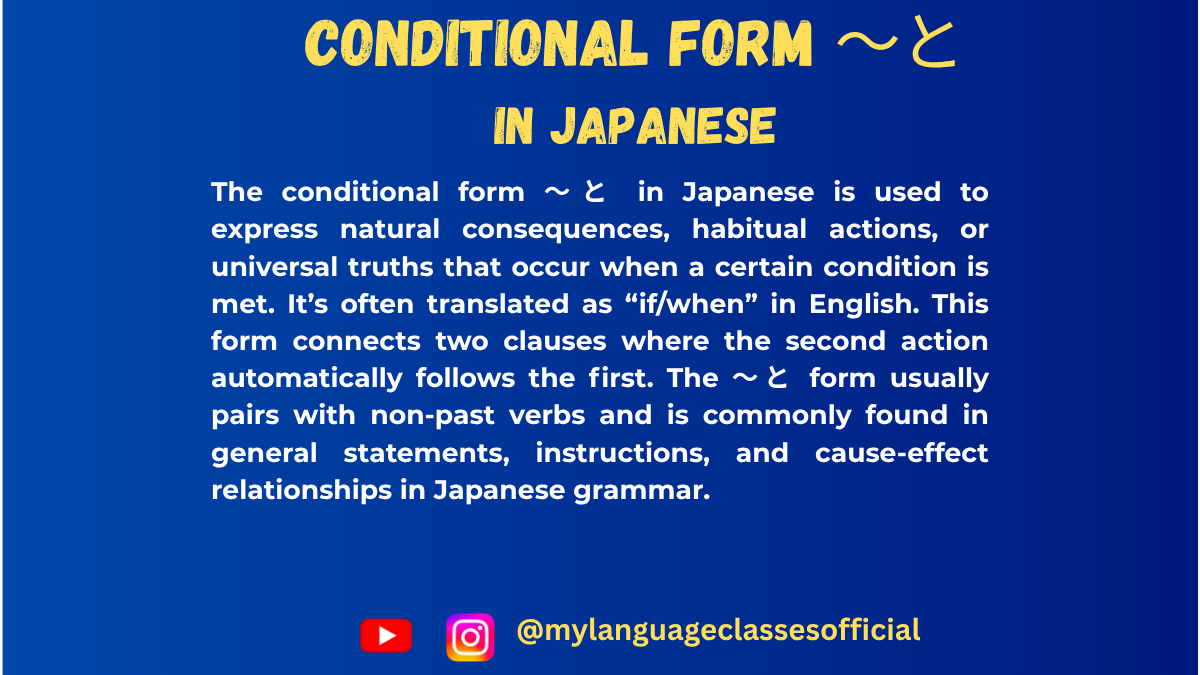
Using 〜と for Natural Consequence | My Language Classes
Expressing a Natural Consequence in Japanese: 〜と
In Japanese, the particle 〜と has a variety of usages, but it is commonly employed to express natural consequences, conditions, or outcomes. Understanding 〜と is essential for mastering conditional sentences and making logical connections between actions or states.
This blog post will explore the various situations where 〜と is used, providing detailed explanations and examples to help you grasp its nuances.
Primary Uses of 〜と
- Expressing a Natural or Inevitable Consequence When 〜と is used, it implies that the result is a natural or automatic outcome of the preceding action or condition. This is particularly common in scientific or logical statements.Structure:
- Clause A と Clause B
(When Clause A happens, Clause B naturally follows.)
- ボタンを押すと、ドアが開きます。
(When you press the button, the door opens.) - 冬になると、雪が降ります。
(When it becomes winter, it snows.)
- Clause A と Clause B
- Habitual Actions or Repeated Outcomes
〜と can describe a habitual action or repeated phenomenon triggered by a condition.Examples:- 朝起きると、コーヒーを飲みます。
(When I wake up in the morning, I drink coffee.) - 毎回この歌を聞くと、昔を思い出します。
(Every time I hear this song, I remember the past.)
- 朝起きると、コーヒーを飲みます。
- Discoveries or Unexpected Realizations
〜と is used to describe a situation where the speaker discovers something upon performing an action.Examples:- ドアを開けると、猫がいました。
(When I opened the door, there was a cat.) - 山の頂上に着くと、美しい景色が広がっていました。
(When I reached the mountain summit, a beautiful view spread out before me.)
- ドアを開けると、猫がいました。
- Warnings and Hypothetical Negative Outcomes
〜と can express a warning or a negative consequence if a certain action is performed.Examples:- 急がないと、電車に乗り遅れますよ。
(If you don’t hurry, you’ll miss the train.) - そんなことをすると、後で後悔しますよ。
(If you do such a thing, you’ll regret it later.)
- 急がないと、電車に乗り遅れますよ。
- Instructions or Rules in Conditional Situations
In formal contexts, 〜と is used to convey instructions, rules, or expected outcomes.Examples:- お金を入れると、商品が出てきます。
(When you insert money, the product comes out.) - このボタンを押すと、エンジンがスタートします。
(When you press this button, the engine starts.)
- お金を入れると、商品が出てきます。
Key Differences Between 〜と and Other Conditional Particles
- 〜と vs 〜ば
While both can describe conditions, 〜ば focuses more on hypothetical or general conditions, whereas 〜と emphasizes a natural or inevitable result.
Example:- 〜と: 雨が降ると、道が濡れます。
(When it rains, the roads get wet.) - 〜ば: 雨が降れば、試合は中止になるでしょう。
(If it rains, the match will likely be canceled.)
- 〜と: 雨が降ると、道が濡れます。
- 〜と vs 〜たら
〜たら is often used for one-time conditions or events and can handle past-tense conditions, unlike 〜と.
Example:- 〜と: 春になると、桜が咲きます。
(When it becomes spring, cherry blossoms bloom.) - 〜たら: 春になったら、旅行に行きたいです。
(When it becomes spring, I want to travel.)
- 〜と: 春になると、桜が咲きます。
List of Situations Where 〜と Is Used
- Natural or inevitable consequences.
- Habitual actions or consistent outcomes.
- Discoveries or unexpected realizations.
- Warnings or hypothetical negative outcomes.
- Instructions, rules, or predictable results in formal contexts.
Points to Remember About 〜と
- Non-Intentional Clause B:
The second clause (Clause B) must describe something out of the speaker’s control, such as a fact, habitual action, or natural consequence. - No Past-Tense Clause A:
The first clause (Clause A) cannot be in the past tense.
Example:- Incorrect: 彼が来たと、部屋が明るくなった。
- Correct: 彼が来ると、部屋が明るくなった。
(When he comes, the room becomes brighter.)
- Clear Cause-and-Effect Relationship:
There must be a logical and automatic relationship between Clause A and Clause B.
Mastering 〜と will enhance your ability to create logical, fluent sentences in Japanese. By understanding its nuances and contexts, you’ll find it easier to express cause-and-effect relationships and describe habitual or natural outcomes in daily conversation and writing.
If you enjoyed this lesson, be sure to check out more posts like this on my blog at My Language Classes. Don’t forget to subscribe my YouTube channel and follow me on Instagram for the latest language learning tips and lessons. Leave a comment below to share your thoughts, or ask any questions you have about nouns.
Happy learning! 😊
- Expressing a Natural or Inevitable Consequence When 〜と is used, it implies that the result is a natural or automatic outcome of the preceding action or condition. This is particularly common in scientific or logical statements.Structure:
-

Understanding 〜たら (If/When) | My Language Classes
Understanding the Conditional “If” or “When” in Japanese
Japanese is a beautifully nuanced language, and understanding its conditional expressions is essential to mastering its grammar. Among these, 〜たら is one of the most versatile and commonly used forms to express conditionality. While it often translates to “if” or “when” in English, its usage varies depending on context. In this blog post, we’ll dive into everything you need to know about 〜たら, including its formation, usage, and specific examples for different scenarios.
What is 〜たら?
The term 〜たら comes from the た-form of verbs, adjectives, or copulas, combined with the particle ら. This construction is used to describe a condition that must be met for the second clause to occur. Its meaning can vary depending on the time and certainty implied in the context.
Formation:
- Verbs:
Base verb (た-form) + ら
Example: 食べる (to eat) → 食べたら (if/when [you] eat) - Adjectives (い-adjectives):
Drop the い, add かった, then add ら.
Example: 楽しい (fun) → 楽しかったら (if/when [it’s] fun) - Adjectives (な-adjectives) & Nouns:
Add だったら after the base word.
Example: 静か (quiet) → 静かだったら (if/when [it’s] quiet)
学生 (student) → 学生だったら (if/when [you’re] a student)
When to Use 〜たら
〜たら is used in a variety of scenarios, and understanding the context is key to choosing the right conditional expression in Japanese. Below are the primary uses of 〜たら with examples.
1. Hypothetical Conditions (“If”)
When describing a situation that may or may not happen, 〜たら acts like “if” in English.
- Example:
雨が降ったら、家にいます。
(If it rains, I’ll stay home.)
2. Temporal Conditions (“When”)
〜たら can indicate “when” for an action that will happen after the condition is met.
- Example:
宿題が終わったら、遊びに行きましょう。
(When you finish your homework, let’s go play.)
3. Unrealistic or Imaginary Conditions
When discussing hypothetical scenarios that are unlikely or purely imaginary, 〜たら is the go-to form.
- Example:
お金持ちだったら、世界中を旅行したい。
(If I were rich, I would like to travel the world.)
4. Unexpected Results
In some cases, the action in the second clause is surprising or contrary to what was expected from the condition in the first clause.
- Example:
ドアを開けたら、猫がいました。
(When I opened the door, there was a cat.)
[Note: The speaker didn’t expect a cat to be there.]
5. Past Actions Followed by Realization
〜たら is also used when an action is completed, and the speaker realizes or learns something new afterward.
- Example:
その映画を見たら、泣いてしまった。
(When I watched that movie, I ended up crying.)
6. Conditional Advice or Suggestions
To offer advice or make suggestions contingent on a condition.
- Example:
疲れたら、休んだほうがいいですよ。
(If you’re tired, you should take a rest.)
List of Situations Where 〜たら is Used
Here’s a concise list of common situations where 〜たら appears:
- Hypothetical conditions: Speculating about what might happen.
- Temporal conditions: Actions that occur sequentially.
- Unrealistic conditions: Hypothetical scenarios (e.g., dreams or fantasies).
- Surprising or unexpected outcomes: Actions that yield unforeseen results.
- Post-event realization: Discoveries made after completing an action.
- Giving advice or suggestions: Contingent recommendations.
- Plans based on conditions: Situations where future actions depend on prior conditions.
How is 〜たら Different from Other Conditionals?
Japanese has several conditional forms, such as と, ば, and なら, which can sometimes overlap in meaning. Here’s how 〜たら compares:
- 〜たら is versatile and works for past, present, and future conditions, as well as hypothetical and temporal situations.
- と emphasizes natural consequences or inevitable results (e.g., “If you press this button, the door will open”).
- ば is more formal and focuses on hypothetical or logical outcomes.
- なら introduces a topic or focuses on conditions assumed to be true (e.g., “If it’s about Tokyo, I know a lot”).
Practice Makes Perfect!
To truly master 〜たら, practice creating sentences for various scenarios. Start with simple sentences like:
- 雨が降ったら、どうしますか?
(If it rains, what will you do?)
Then, challenge yourself with complex structures:
- この本を読んだら、新しい考え方が学べると思います。
(I think if you read this book, you’ll learn a new way of thinking.)
Conclusion
Understanding 〜たら is essential for fluency in Japanese. Its flexibility allows it to cover a range of situations, from hypothetical scenarios to real-life sequential actions. By practicing its usage and comparing it to other conditionals, you’ll be able to express yourself naturally and accurately in Japanese. Remember, context is everything, so keep practicing, and soon enough, using 〜たら will feel as natural as saying “if” or “when” in English!
If you enjoyed this lesson, be sure to check out more posts like this on my blog at My Language Classes. Don’t forget to subscribe my YouTube channel and follow me on Instagram for the latest language learning tips and lessons. Leave a comment below to share your thoughts, or ask any questions you have about nouns.
Happy learning! 😊
- Verbs:
-
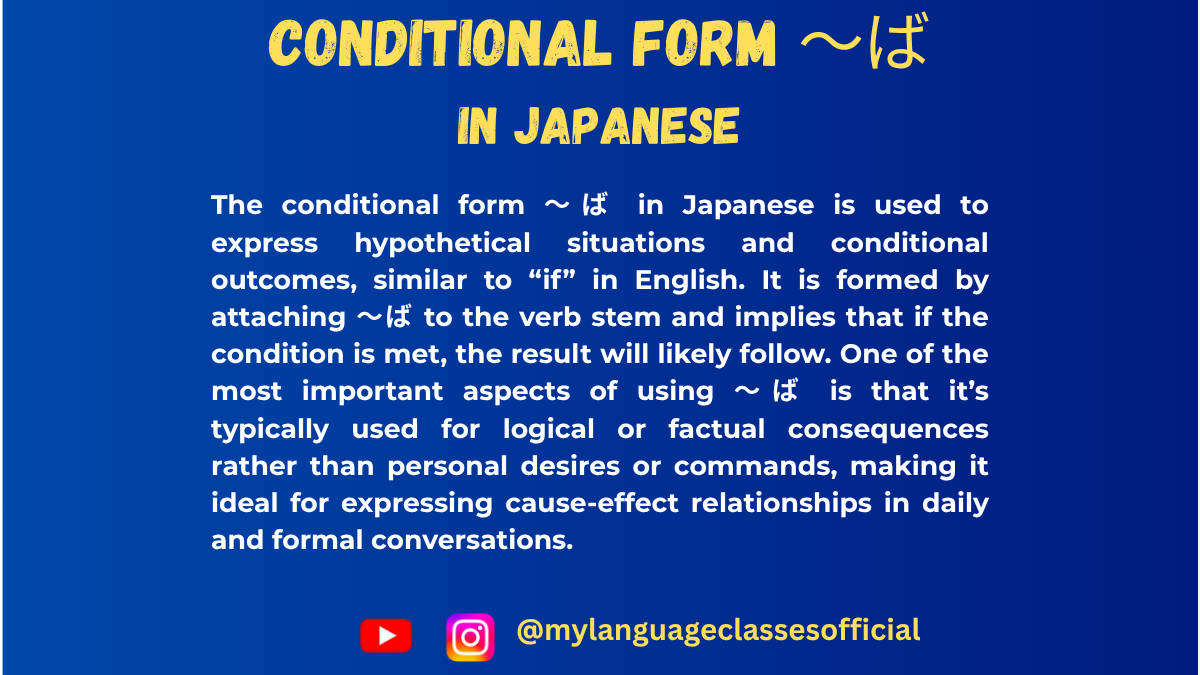
Using 〜ば (Conditional) | My Language Classes
Understanding 〜ば: The Conditional Form in Japanese
The Japanese conditional form 〜ば is an essential grammatical structure used to express conditions, similar to “if” or “when” in English. It provides a flexible way to convey cause-and-effect relationships, hypothetical situations, and natural consequences. Let’s dive deep into its usage, exploring its nuances, and highlight situations where it can be used effectively.
What is 〜ば?
The particle 〜ば attaches to the stem of verbs or adjectives to create a conditional clause. It is equivalent to saying, “If [X], then [Y].”
How to Form 〜ば?
- For Verbs:
- Take the dictionary form of a verb.
- Convert the verb to its 仮定形 (hypothetical form) by changing the ending:
- Group 1 (五段動詞): Change the last character to its え-sound + ば.
- Example: 行く → 行けば
- Group 2 (一段動詞): Replace る with れば.
- Example: 食べる → 食べれば
- Irregular verbs:
- する → すれば
- くる → くれば
- Group 1 (五段動詞): Change the last character to its え-sound + ば.
- Result:
- Verb stem + ば = Conditional form.
- For Adjectives:
- い-adjectives:
- Drop the final い and add ければ.
- Example: 高い → 高ければ
- Drop the final い and add ければ.
- な-adjectives:
- Add ならば after the adjective stem.
- Example: 静か → 静かならば
- Add ならば after the adjective stem.
- い-adjectives:
- For Nouns:
- Add ならば after the noun.
- Example: 学生 → 学生ならば
- Add ならば after the noun.
Usage of 〜ば
- To Express Hypothetical Conditions
When you want to describe a situation that may or may not happen, 〜ば is perfect for creating “if” clauses.- Example:
明日雨が降れば、試合は中止です。
If it rains tomorrow, the match will be canceled.
- Example:
- To Indicate Natural or Logical Consequences
〜ば is often used to explain cause-and-effect relationships that feel natural.- Example:
努力すれば、成功します。
If you make an effort, you will succeed.
- Example:
- To Offer Suggestions or Advice
In conversational Japanese, 〜ば can give a softer tone when offering suggestions.- Example:
もっと早く寝れば、疲れが取れますよ。
If you sleep earlier, you’ll feel less tired.
- Example:
- To Express Regret or Reflection (Negative 〜ば)
When used in hindsight or regret, negative forms with 〜ば are common.- Example:
あの時、行かなければよかった。
I should not have gone at that time.
- Example:
- To Indicate Conditions for General Truths
Use 〜ば for statements that hold universally true under specific conditions.- Example:
火をつければ、水は蒸発する。
If you apply heat, water evaporates.
- Example:
- In Hypothetical Questions
〜ば is sometimes used to ask “what if” questions.- Example:
もし宝くじが当たれば、何をしますか?
If you win the lottery, what would you do?
- Example:
- Paired with Expressions of Hope or Desire
Combine 〜ば with verbs like いい or よい to express a wish or hope.- Example:
雨が止めばいいですね。
I hope the rain stops.
- Example:
- To Express Dependency
Describing situations where one thing depends on another.- Example:
彼が来れば、私たちは始めます。
If he comes, we will start.
- Example:
Key Points and Usage Notes
- Difference Between 〜ば and Other Conditionals (〜たら, 〜と, なら):
- 〜ば: Focuses on logical relationships and is often used for cause and effect.
- 〜たら: More versatile, used for real or imagined situations, often for past and specific contexts.
- 〜と: Used for natural consequences or habitual actions.
- 〜なら: Highlights conditions and is often used to suggest or clarify.
- 雨が降れば、試合は中止です。 (Logical relationship)
- 雨が降ったら、試合は中止です。 (Specific context, imagining the situation)
- 雨が降ると、試合は中止です。 (Natural consequence, habitual)
- 雨なら、試合は中止です。 (Condition clarified, suggesting understanding)
- Avoid Overusing 〜ば in Casual Speech:
While grammatically correct, 〜ば can sound formal or academic. For casual conversations, 〜たら or 〜と may be more natural. - Negating 〜ば:
To negate, use 〜なければ.- Example:
時間がなければ、参加しなくてもいいです。
If you don’t have time, you don’t need to participate.
- Example:
- Hypothetical Past with Regret:
Combine with expressions like よかった to express past hypotheticals.- Example:
もっと頑張ればよかった。
I should have tried harder.
- Example:
Situations Where 〜ば is Used
Here’s a summary of situations where you can use 〜ば effectively:
- Expressing hypothetical conditions.
- Explaining logical or natural consequences.
- Offering advice or suggestions.
- Reflecting on regrets or hindsight.
- Describing general truths or universal principles.
- Posing hypothetical or “what if” questions.
- Expressing hope or desire.
- Indicating dependencies between actions or events.
Practice Exercises
- Convert the following sentences into the 〜ば form:
- 明日、時間があるなら、一緒に映画を見ます。
- 成績が悪いと、両親に怒られます。
- Translate these English sentences into Japanese using 〜ば:
- If you study every day, you will pass the test.
- If it’s cold, let’s drink hot tea.
Mastering 〜ば will open up a range of expressive possibilities in your Japanese communication. With practice, you’ll find it natural to use this conditional form in both formal and everyday contexts. Keep practicing and experiment with its flexibility to become more fluent!
If you enjoyed this lesson, be sure to check out more posts like this on my blog at My Language Classes. Don’t forget to subscribe my YouTube channel and follow me on Instagram for the latest language learning tips and lessons. Leave a comment below to share your thoughts, or ask any questions you have about nouns.
Happy learning! 😊
- For Verbs:
-
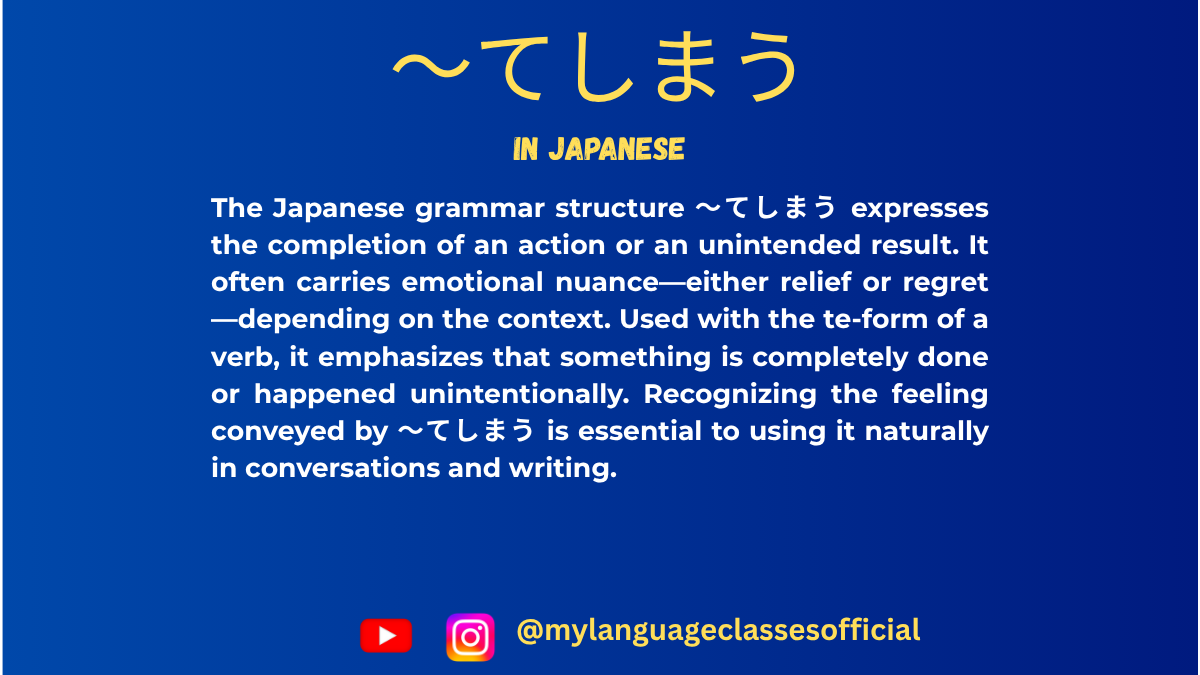
Expressing Completion or Regret in Japanese:〜てしまう| My Language Classes
Using 〜てしまう in Japanese
In Japanese, the grammar structure 〜てしまう plays a significant role in expressing either the completion of an action or a sense of regret, often depending on the context. This nuanced construction can elevate your Japanese proficiency, helping you convey subtle emotions and intentions effectively.
Let’s delve into its usage, nuances, and common situations where it applies.
What is 〜てしまう?
The form 〜てしまう is derived by attaching しまう to the て-form of a verb. The meaning can vary based on context, and it is commonly shortened in casual speech to 〜ちゃう or 〜じゃう.
- Completion: Indicates that an action has been entirely or thoroughly completed.
- Regret/Unintended Outcome: Expresses a sense of regret, disappointment, or that something happened unintentionally.
How to Form 〜てしまう
- Take the て-form of the verb.
- Example: 飲む (to drink) → 飲んで
- Add しまう.
- 飲んでしまう (to finish drinking or drink unintentionally)
Casual Contractions:
- 〜てしまう → 〜ちゃう
- 飲んでしまう → 飲んじゃう
- 〜でしまう → 〜じゃう
- 食べてしまう → 食べちゃう
Situations Where 〜てしまう is Used
- Expressing Completion of an Action
- Used to indicate that an action is finished, often with a sense of thoroughness or finality.
- Example:
- 宿題を全部やってしまいました。 (I finished all my homework.)
- ケーキを食べてしまった。 (I ate the entire cake.)
- Expressing Regret or an Unintended Outcome
- When an action leads to an unintended or regrettable result.
- Example:
- 大事な書類をなくしてしまった。 (I lost an important document.)
- 電車に傘を忘れてしまいました。 (I accidentally left my umbrella on the train.)
- Expressing Uncontrollable Situations
- Used to convey situations beyond the speaker’s control.
- Example:
- 窓が風で閉まってしまった。 (The window shut because of the wind.)
- Expressing Emotional Impact
- Can emphasize feelings of surprise, disappointment, or unintended consequences.
- Example:
- こんなに早く雨が降ってしまうなんて思わなかった。 (I didn’t think it would start raining so soon.)
- Hypothetical or Future Concerns
- Used when imagining an unintended or regretful scenario in the future.
- Example:
- テストで間違えてしまうかもしれない。 (I might make a mistake on the test.)
Key Points to Remember
- Context is Crucial:
- Depending on the situation, 〜てしまう can mean either “to finish” or “to regret.” The tone, verb, and surrounding context clarify its intended meaning.
- Shortened Forms are Common:
- In casual conversation, the contracted forms ちゃう and じゃう are more commonly used.
- Polite vs. Casual Speech:
- Formal: 書いてしまいました。 (I finished writing.)
- Casual: 書いちゃった。 (I finished writing.)
- Adding Emotional Nuance:
- Using 〜てしまう adds depth to your expression, allowing you to highlight feelings of regret, completion, or an unexpected event.
Examples of Common Scenarios
Situation Example Sentence Translation Accidental Action コーヒーをこぼしてしまいました。 (I accidentally spilled the coffee.) Forgot Something 鍵を家に忘れてしまった。 (I left my keys at home.) Regretful Action 寝坊してしまった。 (I overslept.) Uncontrollable Event 雨が降ってしまった。 (It started raining.) Complete Action 本を全部読んでしまいました。 (I finished reading the entire book.) Hypothetical Concern 試験に遅れてしまうかもしれない。 (I might be late for the exam.)
Why Use 〜てしまう?
- Adds Emotional Depth:
- Helps convey your feelings of regret, surprise, or relief.
- Expresses Finality:
- Perfect for emphasizing the completion of an action.
- Natural and Fluent Japanese:
- Using 〜てしまう naturally in conversation makes your Japanese sound more native-like.
Practice Tip: Try incorporating 〜てしまう in daily life scenarios or journaling your day in Japanese. Write about actions you completed, unintended events, or things you regretted doing.
Example Practice Sentence:
- 昨日、友達に秘密を言ってしまいました。 (Yesterday, I accidentally told my friend a secret.)
By mastering 〜てしまう, you’ll enhance your ability to express subtle emotions and actions naturally, making your Japanese more dynamic and expressive.
If you enjoyed this lesson, be sure to check out more posts like this on my blog at My Language Classes. Don’t forget to subscribe my YouTube channel and follow me on Instagram for the latest language learning tips and lessons. Leave a comment below to share your thoughts, or ask any questions you have about nouns.
Happy learning! 😊
-
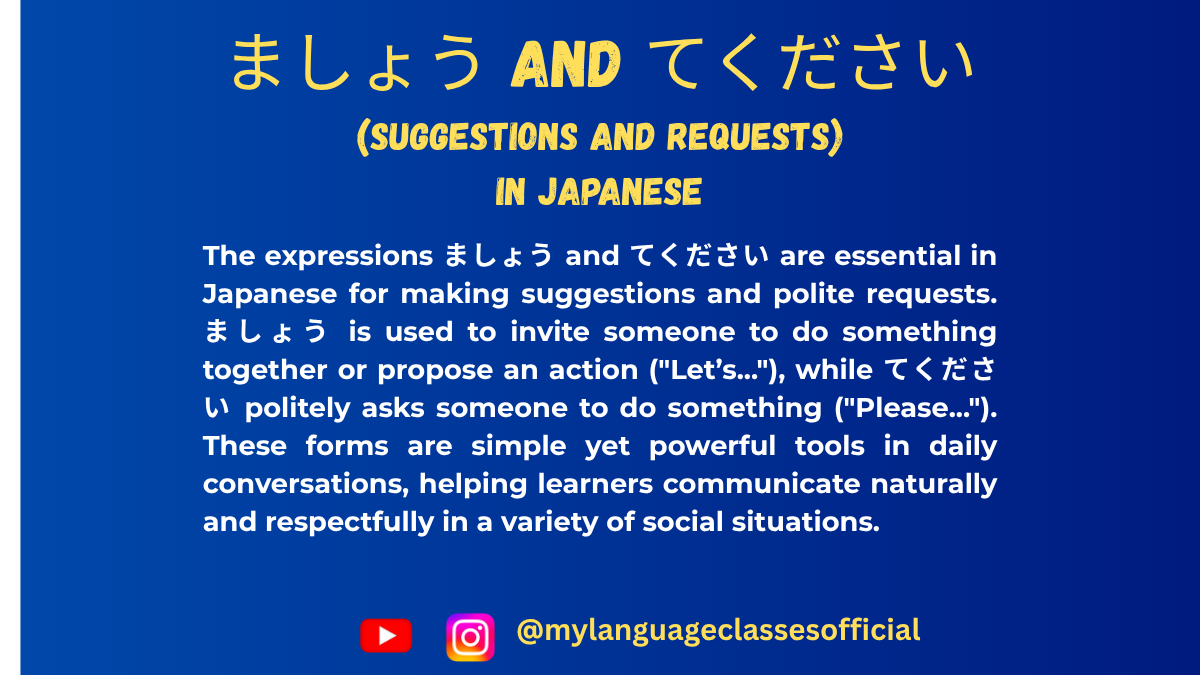
Making Suggestions and Polite Requests ましょう and てください in Japanese | My Language Classes
Mastering Polite Suggestions and Requests in Japanese
If you’re learning Japanese, understanding how to make polite suggestions and requests is a key part of effective communication. Whether you’re planning activities with friends or politely asking for help, two common expressions—Verb stem + ましょう and Verb stem + てください—are your go-to tools. Let’s dive into their usage, including how to form them step by step.
1. Making Suggestions with ましょう (mashou): “Let’s [verb]”
The expression ましょう is a polite and versatile way to suggest an activity or propose an idea. It carries a collaborative tone, meaning “Let’s do [verb].”
How to Form the ましょう Form
Japanese verbs are divided into three groups, and the method for creating the ましょう form depends on the group.
Group 1: U-Verbs (Godan Verbs)
- Start with the stem of the verb (remove the u-ending).
- Replace the u sound with the i sound.
- Add ましょう.
Verb Stem Change to i Form Add ましょう Example Translation 行く 行 行き 行きましょう Let’s go. 書く 書 書き 書きましょう Let’s write. 話す 話 話し 話しましょう Let’s talk.
Group 2: Ru-Verbs (Ichidan Verbs)
- Remove the final る.
- Add ましょう.
Verb Stem Add ましょう Example Translation 食べる 食べ 食べましょう Let’s eat. 見る 見 見ましょう Let’s look.
Group 3: Irregular Verbs
There are two irregular verbs, and their ましょう forms are as follows:
Verb Change to Stem Add ましょう Example Translation する し しましょう Let’s do it. 来る (kuru) 来 (ki) 来ましょう Let’s come.
When to Use ましょう
- Planning with others:
Example: 公園へ行きましょう!(Kōen e ikimashou!) = Let’s go to the park! - Encouraging teamwork:
Example: 一緒に勉強しましょう。(Issho ni benkyou shimashou.) = Let’s study together.
The tone is polite, making it suitable for formal and casual settings, as long as it’s a group-oriented activity.
2. Making Requests with てください (tekudasai): “Please [verb]”
Before diving into てください, we need to understand how to form the te-form of verbs. The te-form is one of the most fundamental conjugations in Japanese grammar and is used in various contexts beyond requests, such as making commands, linking actions, and creating the polite request structure てください.
How to Make the Te-Form
Japanese verbs are categorized into three groups, and the rules for forming the te-form differ depending on the group.
Group 1: U-Verbs (Godan Verbs)
For verbs ending in う, つ, る, む, ぶ, ぬ, く, ぐ, す, follow these rules:
- Replace the final u-sound with its corresponding te-form sound:
Ending Te-Form Rule Example う Replace with って 買う (kau) → 買って (katte) = Buy つ Replace with って 立つ (tatsu) → 立って (tatte) = Stand る Replace with って 取る (toru) → 取って (totte) = Take む Replace with んで 読む (yomu) → 読んで (yonde) = Read ぶ Replace with んで 遊ぶ (asobu) → 遊んで (asonde) = Play ぬ Replace with んで 死ぬ (shinu) → 死んで (shinde) = Die く Replace with いて 書く (kaku) → 書いて (kaite) = Write ぐ Replace with いで 泳ぐ (oyogu) → 泳いで (oyoide) = Swim す Replace with して 話す (hanasu) → 話して (hanashite) = Speak
Group 2: Ru-Verbs (Ichidan Verbs)
For verbs ending in る, simply drop る and add て:
- 食べる (taberu) → 食べて (tabete) = Eat.
- 見る (miru) → 見て (mite) = Look.
Group 3: Irregular Verbs
There are only two irregular verbs in Japanese:
- する → して = Do.
Example: 勉強する (benkyou suru) → 勉強して (benkyou shite) = Study. - 来る (kuru) → 来て (kite) = Come.
Forming てください
Once you have the te-form of a verb, simply add ください to make a polite request:
- 見る (miru) → 見て (mite) + ください = 見てください (mite kudasai) = Please look.
- 書く (kaku) → 書いて (kaite) + ください = 書いてください (kaite kudasai) = Please write.
- 手伝う (tetsudau) → 手伝って (tetsudatte) + ください = 手伝ってください (tetsudatte kudasai) = Please help.
When to Use It
- Asking politely:
Example: ちょっと待ってください。(Chotto matte kudasai.) = Please wait a moment. - Giving instructions:
Example: ドアを閉めてください。(Doa o shimete kudasai.) = Please close the door.
This phrase is polite and commonly used in both formal and informal situations.
Key Differences Between ましょう and てください
Expression Purpose Tone Verb stem + ましょう Suggestion: “Let’s do [verb]” Collaborative and inclusive Verb stem + てください Request: “Please do [verb]” Respectful and polite
Quick Practice: Try It Out!
Let’s put these into practice. Can you guess the correct form for each scenario?
- You’re suggesting to a friend: “Let’s watch a movie.”
Hint: The verb is 見る (miru).
Answer: 映画を見ましょう!(Eiga o mimashou!) - You’re asking someone politely: “Please listen to me.”
Hint: The verb is 聞く (kiku).
Answer: 私の話を聞いてください。(Watashi no hanashi o kiite kudasai.)
Conclusion
Mastering ましょう and てください opens up a world of polite and smooth communication in Japanese. By understanding these structures—and learning how to form the te-form and ましょう—you can make suggestions, request actions, and navigate various social situations with confidence. Practice them in your daily conversations, and soon they’ll become second nature!
What are your favorite phrases using ましょう or てください? Share them in the comments below! Or, if you have any questions about Japanese grammar, feel free to ask. Let’s keep learning together—日本語を楽しみましょう!(Nihongo o tanoshimimashou!) 😊
If you enjoyed this lesson, be sure to check out more posts like this on my blog at My Language Classes. Don’t forget to subscribe my YouTube channel and follow me on Instagram for the latest language learning tips and lessons. Leave a comment below to share your thoughts, or ask any questions you have about nouns.
Happy learning! 😊
-
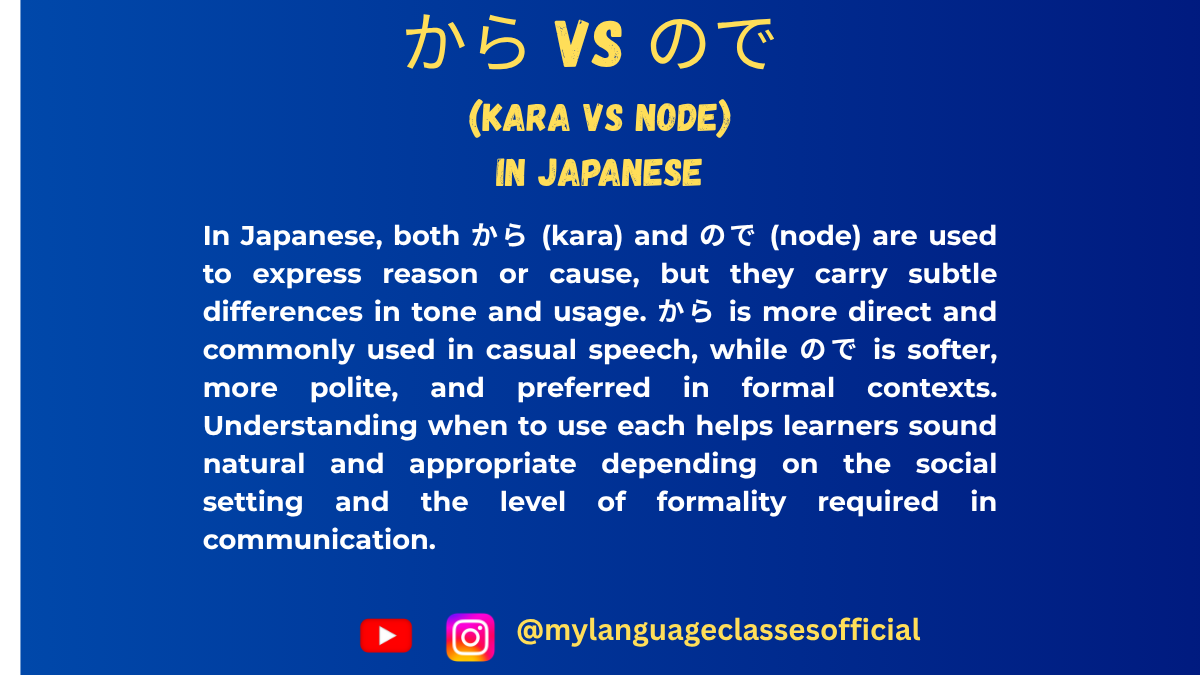
How to Say “Because” in Japanese から (kara) vs. ので (node) | My Language Classes
Expressing “Because” in Japanese: から (kara) vs. ので (node)
When learning Japanese, understanding how to express “because” is essential for forming logical connections in your sentences. Two primary tools for this are から (kara) and ので (node). Both translate roughly to “because” or “since,” but their nuances and appropriate contexts differ. In this post, we’ll explore their meanings, usage, and subtle differences to help you master them.
1. Understanding から (kara)
から is a versatile and commonly used particle to indicate cause and effect. Its usage is straightforward and can be found in both casual and formal contexts, though it often leans more casual.
Structure:
- Reason + から + Result
- Example: 勉強しなかったから、試験に落ちました。
(Benkyou shinakatta kara, shiken ni ochimashita.)
“Because I didn’t study, I failed the exam.”
- Example: 勉強しなかったから、試験に落ちました。
Key Features:
- Direct and Conversational:
から is widely used in everyday speech. It gives a clear and sometimes blunt explanation of reasons.- Example: 雨が降っているから、外に行きません。
(Ame ga futteiru kara, soto ni ikimasen.)
“Because it’s raining, I won’t go outside.”
- Example: 雨が降っているから、外に行きません。
- Flexible Placement:
You can use から in both written and spoken Japanese, though it feels more natural in informal contexts. - Focus on the Speaker’s Perspective:
The reason expressed with から often reflects the speaker’s opinion or justification.
2. Understanding ので (node)
ので is another way to express “because,” but it has a softer, more polite tone. It’s commonly used in formal situations or when you want to sound less direct or imposing.
Structure:
- Reason + ので + Result
- Example: 雨が降っているので、外に行きません。
(Ame ga futteiru node, soto ni ikimasen.)
“Since it’s raining, I won’t go outside.”
- Example: 雨が降っているので、外に行きません。
Key Features:
- Polite and Subtle:
ので carries a sense of consideration, making it ideal for formal or respectful conversations.- Example: お腹が空いたので、何か食べましょう。
(Onaka ga suita node, nanika tabemashou.)
“Since I’m hungry, let’s eat something.”
- Example: お腹が空いたので、何か食べましょう。
- Softer Implications:
Compared to から, ので feels less assertive and more explanatory. It’s often used when the reason is more objective or when you’re asking for understanding. - Common in Formal Writing and Speech:
You’ll frequently see ので in polite correspondence, workplace conversations, and when addressing superiors.
3. Key Differences Between から and ので
Aspect から ので Tone Direct, casual Polite, formal, soft Usage Everyday conversations Formal writing and respectful speech Reason Type Subjective or personal Objective or neutral Politeness Level Casual to neutral Neutral to polite Examples Highlighting the Differences:
- Casual Statement:
- 勉強しなかったから、試験に落ちた。 (Benkyou shinakatta kara, shiken ni ochita.)
“I failed the exam because I didn’t study.” (Direct and casual) - 勉強しなかったので、試験に落ちました。 (Benkyou shinakatta node, shiken ni ochimashita.)
“I failed the exam since I didn’t study.” (Polite and explanatory)
- 勉強しなかったから、試験に落ちた。 (Benkyou shinakatta kara, shiken ni ochita.)
- Polite Request:
- 道が混んでいたから、遅れました。 (Michi ga kondeita kara, okuremashita.)
“I was late because the roads were crowded.” (Blunt explanation) - 道が混んでいたので、遅れました。 (Michi ga kondeita node, okuremashita.)
“I was late since the roads were crowded.” (Polite and considerate)
- 道が混んでいたから、遅れました。 (Michi ga kondeita kara, okuremashita.)
4. When to Use Which?
Use から When:
- Speaking casually with friends or family.
- Explaining personal reasons directly.
- Adding emphasis to the cause-effect relationship.
Use ので When:
- Communicating in formal or polite settings.
- Writing formal letters, essays, or workplace emails.
- Explaining reasons with a softer tone to avoid sounding blunt.
5. A Quick Note on Grammar
- から connects to the plain form of a verb, adjective, or noun:
- Verb: 走るから (Hashiru kara, “Because I run”)
- Adjective: 寒いから (Samui kara, “Because it’s cold”)
- Noun + だ: 先生だから (Sensei da kara, “Because I’m a teacher”)
- ので also connects to the plain form, but nouns and な-adjectives require な before ので:
- Verb: 走るので (Hashiru node, “Since I run”)
- Adjective: 寒いので (Samui node, “Since it’s cold”)
- Noun + な: 先生なので (Sensei na node, “Since I’m a teacher”)
6. Practice Makes Perfect!
Understanding から and ので is only the beginning. Try using them in sentences to express reasons for daily activities. For example:
- 電車が遅れたから、会議に間に合いませんでした。
(Densha ga okureta kara, kaigi ni ma ni aimasendeshita.)
“Because the train was delayed, I couldn’t make it to the meeting.” - 電車が遅れたので、会議に間に合いませんでした。
(Densha ga okureta node, kaigi ni ma ni aimasendeshita.)
“Since the train was delayed, I couldn’t make it to the meeting.”
By practicing these expressions in context, you’ll develop an intuitive sense of when to use から and ので, enhancing both your fluency and sensitivity to Japanese communication styles. Keep practicing, and don’t hesitate to mix them into your conversations!
If you enjoyed this lesson, be sure to check out more posts like this on my blog at My Language Classes. Don’t forget to subscribe my YouTube channel and follow me on Instagram for the latest language learning tips and lessons. Leave a comment below to share your thoughts, or ask any questions you have about nouns.
Happy learning! 😊
- Reason + から + Result
-
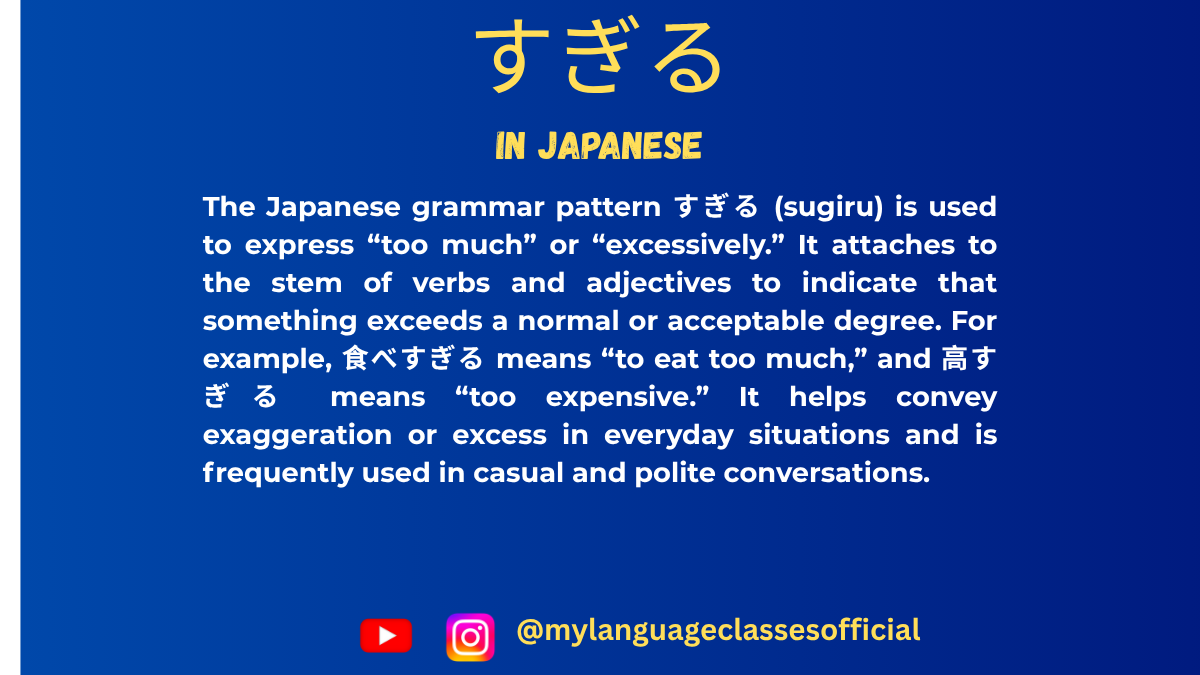
How to Use すぎる in Japanese | My Language Classes
Mastering すぎる: The Key to Expressing Excess in Japanese
When learning Japanese, one of the most versatile tools in your linguistic arsenal is the suffix すぎる (sugiru). This simple yet powerful expression allows you to convey the idea of “too much” or “excessively” with verbs, adjectives, and more. In this blog, we’ll explore how to use it, provide practical examples, and share cultural insights to help you avoid common mistakes.
What Does すぎる Mean?
At its core, すぎる means “to go beyond” or “to exceed.” When attached to the root of a verb or adjective, it transforms the phrase to mean “too much” or “overly.”
For example:- 食べすぎる (tabesugiru): to eat too much.
- 高すぎる (takasugiru): too expensive.
- 使いすぎる (tsukaisugiru): to use too much.
This construction works seamlessly in a wide variety of situations, making it an essential element of everyday conversation.
How to Use すぎる with Verbs
To use すぎる with a verb, follow these steps:
- Take the stem form of the verb (the verb without its final ます in polite form or る in dictionary form).
- Attach すぎる directly to the stem.
Here are some examples:
- 食べる (taberu) → 食べすぎる (tabesugiru): to eat too much.
- 飲む (nomu) → 飲みすぎる (nomisugiru): to drink too much.
- 使う (tsukau) → 使いすぎる (tsukaisugiru): to use too much.
Example sentences:
- 昨日、ラーメンを食べすぎてお腹が痛い。
(Kinō, rāmen o tabesugite onaka ga itai.)
Yesterday, I ate too much ramen, and now my stomach hurts. - 飲み会でお酒を飲みすぎないように気をつけてください。
(Nomikai de osake o nomisuginai yō ni ki o tsukete kudasai.)
Please be careful not to drink too much at the party.
How to Use すぎる with Adjectives
For adjectives, the method depends on whether you’re dealing with an い-adjective or a な-adjective:
1. い-Adjectives
Remove the final い, then add すぎる.
- 高い (takai) → 高すぎる (takasugiru): too expensive.
- 暑い (atsui) → 暑すぎる (atsusugiru): too hot.
Example sentence:
- この服は高すぎて買えない。
(Kono fuku wa takasugite kaenai.)
This clothing is too expensive to buy.
2. な-Adjectives
Simply add すぎる to the base form of the adjective.
- 簡単な (kantanna) → 簡単すぎる (kantansugiru): too simple.
- 静かな (shizukana) → 静かすぎる (shizukasugiru): too quiet.
Example sentence:
- 試験が簡単すぎてびっくりしました。
(Shiken ga kantansugite bikkuri shimashita.)
The test was too easy, and I was surprised.
Nuances and Cultural Tips
- Politeness Matters
In Japanese culture, expressing something as “too much” can sometimes feel blunt. To soften your tone, consider adding phrases like ちょっと (chotto) or using a more indirect expression:
- このラーメン、ちょっと辛すぎると思います。
(Kono rāmen, chotto karasugiru to omoimasu.)
I think this ramen is a little too spicy.
- Avoid Overusing It!
While すぎる is incredibly useful, overusing it can make your speech sound overly critical or negative. Balance it with positive expressions to maintain politeness and harmony in conversations. - Watch for Literal vs. Figurative Use
Sometimes, すぎる is used figuratively:
- 考えすぎる (kangaesugiru): to overthink.
- 頑張りすぎる (ganbarisugiru): to try too hard.
These can reflect emotional or mental states rather than physical actions.
Practice Makes Perfect
To truly master すぎる, try creating your own sentences! Use these prompts:
- What’s something you’ve done “too much” recently?
(食べすぎる, 寝すぎる, 遊びすぎる) - Describe something that felt excessive or overwhelming.
(高すぎる, 静かすぎる, 複雑すぎる)
Conclusion
The すぎる construction is indispensable for describing excess in Japanese. Whether you’re eating too much, overthinking, or facing something outrageously expensive, すぎる lets you express it all with precision and nuance.
So, next time you’re practicing Japanese, try experimenting with すぎる. Not only will it enhance your vocabulary, but it will also deepen your understanding of Japanese culture and conversational dynamics.
Happy learning, and don’t study すぎる (sugiru) much! 😊
If you enjoyed this lesson, be sure to check out more posts like this on my blog at My Language Classes. Don’t forget to subscribe my YouTube channel and follow me on Instagram for the latest language learning tips and lessons. Leave a comment below to share your thoughts, or ask any questions you have about nouns.
Happy learning! 😊
